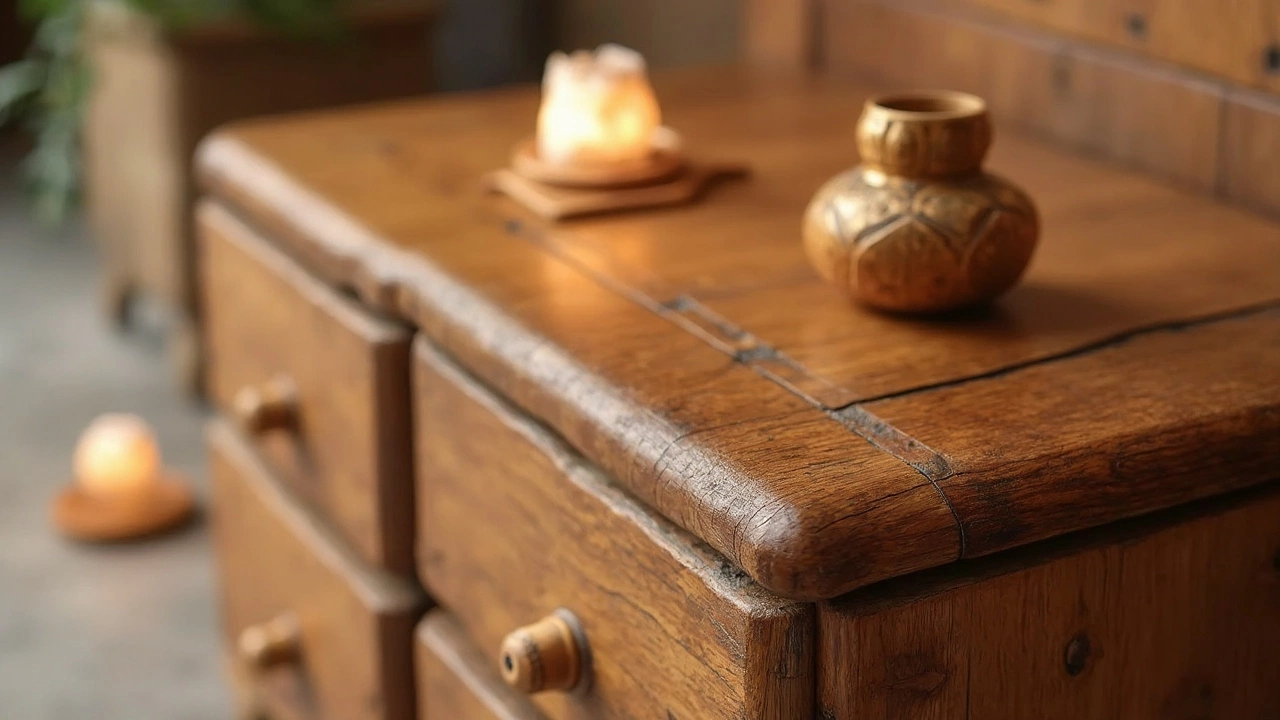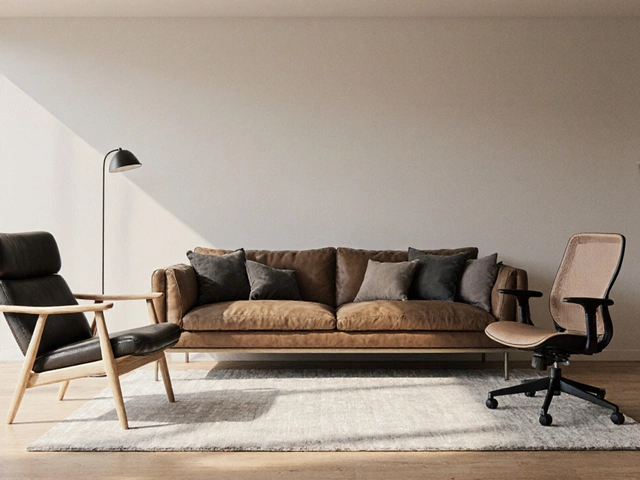When you're in the furniture business, finding cost-effective wood is a bit like searching for treasure. Trust me, sticking to the budget while ensuring quality is tricky but doable. So, what's the cheapest wood you can get your hands on in India? Well, Pine and Mango wood often make the list. These two offer a decent mix of affordability and functionality, making them quite popular among furniture manufacturers.
Now, why is Pine wood often considered? For starters, it's light, easy to work with, and most importantly, budget-friendly. It's perfect if you're looking for something that won't blow up your material costs. But remember, the durability isn't exactly top-notch, so it's more suited for pieces that don't endure daily wear and tear.
- Understanding Wood Pricing in India
- Why Pine Wood Could Be a Smart Choice
- Discover the Versatility of Mango Wood
- Critically Assessing Teak Alternatives
- Tips for Sourcing Affordable Woods
- Balancing Cost and Quality in Furniture Making
Understanding Wood Pricing in India
Diving into wood pricing in India can be a bit of a maze, but let me break it down. Firstly, local availability hugely impacts the cost. Timber like Pine and Mango is relatively cheaper because it's sourced locally, whereas imported woods hike up the expenses due to customs and transport fees.
Supply and demand plays a crucial role too. If a certain type of wood becomes the latest trend in furniture or construction, its price can surge. Similarly, government regulations such as import duties or export bans can also jiggle prices quite a bit.
Factors Affecting Wood Prices
- Quality: The better the quality, the steeper the price. High-grade woods are meticulously selected and treated, while lower grades might have more knots or be less durable.
- Seasonal Availability: Some woods are harder to source during certain seasons, leading to price fluctuations.
- Processing and Treatment: The more processed and treated the wood is, the more it costs. Untreated wood might be cheaper but could require further work before use.
Sample Pricing
Just to give you an idea, the cost for Pine wood can range from INR 400 to INR 600 per cubic foot, while Mango wood often sits between INR 600 and INR 800 per cubic foot. But remember, these numbers can fluctuate depending on the above factors.
By knowing these intricacies of wood pricing in India, you can optimize your choices, ensuring you get the best bang for your buck without skimping on quality.
Why Pine Wood Could Be a Smart Choice
Pine wood is like that friend who’s always there when you need them—reliable and not too pricey. When you're running a furniture business in India, these qualities are gold. You see, Pine is often hailed as one of the most budget-friendly wood options out there. But there's more to it than just the low cost.
Light as a Feather But Strong Enough
Pine is lightweight, which makes it easier to transport and handle, especially when you're churning out multiple pieces of furniture. This lightness doesn’t mean it's fragile. Pine offers decent strength for things like tables and chairs that aren’t subject to heavy daily use. Plus, it holds up pretty well to paints and finishes, letting you customize the look.
Sustainable and Available
If you’re conscious about the environment, Pine is a good option. It's a fast-growing tree, meaning it can be replenished quicker than other slow-growing timber options like Teak. This makes Pine a sustainable choice, and that's a big tick in today’s eco-friendly world. To top it off, its widespread availability in India slashes down any overhead costs associated with long-distance shipping.
Budget Benefits
Let's be real: cost matters. Rather than blowing your budget on expensive woods, Pine helps you keep costs down while not sacrificing too much on durability. This balance makes it a top pick for businesses looking to offer competitive pricing. By saving on material costs, you can invest more in craftsmanship or marketing—whatever makes your business tick.
| Wood Type | Approx. Cost per Cubic Foot (in INR) |
|---|---|
| Pine Wood | 600 - 800 |
| Teak Wood | 1200 - 1500 |
Going for Pine wood could very well be your next smart move if your goal is to produce cost-effective but quality furniture. It’s easy on your pocket, not too hard on the environment, and pretty versatile to boot.
Discover the Versatility of Mango Wood
Mango wood, known for its versatility, is turning heads in the world of furniture materials across India. If you're looking for something affordable and eco-friendly, this wood might just be your new best friend.
So, what makes Mango wood so appealing? For starters, it's not only cheap wood, but it's also sustainable. Mango trees are primarily grown for their fruit, and once they've reached maturity, they're cut down, making room for new plantations. The leftover wood is then repurposed for furniture manufacturing. Talk about a win-win for the environment and your wallet.
Durability and Aesthetics
While some might think that cheaper wood lacks durability, that's not entirely true for Mango. It's sturdy enough for indoor furniture like tables, cabinets, and bed frames. Plus, its distinct grain patterns add a nice touch of elegance to any piece.
Working with Mango Wood
The good news for artisans? Mango wood is easy to work with, whether you plan to carve intricate designs or go for a sleek, modern finish. It takes wood stain beautifully, so you can customize your creations to suit different tastes.
Common Uses
- Tables and chairs
- Cabinets and shelves
- Indoor decorative items
Next time you find yourself on the lookout for affordable timber, give a thought to Mango wood. It's like finding a hidden gem that balances beauty, practicality, and environmental friendliness without breaking the bank. Embracing affordable timber options like Mango can allow furniture makers to keep costs low and design versatile pieces that appeal to a broad audience.

Critically Assessing Teak Alternatives
Teak is often considered the golden standard for furniture making in India, celebrated for its durability and rich appearance. But let's face it, it's not easy on the wallet. So what are Teak alternatives that can deliver both quality and affordability?
Advantages of Teak Alternatives
First up, we have Mango wood. It's quite the underdog, offering an exotic look at a fraction of the price. One of its best features is its sustainability, making it an eco-friendly choice for manufacturers. It's also versatile, perfect for giving that rustic or contemporary touch.
Another player in the field is Sheesham, also known as Indian Rosewood. It's slightly pricier than Mango but still cheaper than Teak. Sheesham is durable, termite-resistant, and adds a beautiful grain to any furniture piece, making it a favorite for cabinets and beds.
According to Rajiv Menon, a renowned furniture designer, "Choosing the right wood involves a mix of budget management and aesthetic vision. Mango and Sheesham offer the best of both worlds without compromising on quality."
Wood Comparing: What's in the Looks?
| Wood Type | Price Range (per cubic ft) | Durability |
|---|---|---|
| Mango | $3-$5 | Good |
| Sheesham | $10-$15 | Excellent |
| Teak | $25-$30 | Excellent |
Sourcing and Quality Tips
When you're on the hunt for these woods, sourcing locally could save costs. You'll find that many carpenters and small mills offer great deals on Mango and Sheesham. Checking for certifications isn't just about ethics; it ensures you're getting genuine, seasoned wood that won’t warp or crack down the line.
So, whether you're crafting dining tables, wardrobes, or small decor items, these affordable timber options enable you to meet client needs without stretching your budget. Shift away from Teak without sacrificing quality or aesthetic appeal.
Tips for Sourcing Affordable Woods
Finding cheap wood in India is a balancing act between cost, quality, and availability. It’s no secret that sourcing the right materials can make or break your business. So, here are some practical ways to get the best deals without compromising your end product.
Explore Local Suppliers
One of the simplest strategies is to check out local timber markets. You'll often find Mango and Pine wood here at competitive prices given they’re locally sourced. This not only cuts transport costs but also supports local businesses.
Stay Updated with Market Trends
Market prices for wood can fluctuate based on demand and supply cycles. Keep an eye on industry reports so you can capitalize on price drops. Sometimes plantations will have surplus, leading to reduced prices for various types of timber.
Bulk Buying
If you’ve got the storage space, buying in bulk can bring substantial savings. Many suppliers offer discounts for larger orders. But remember, it’s crucial to assess your storage conditions to avoid any deterioration in quality.
Engage in Negotiations
Don’t shy away from negotiating with suppliers. If you've got a longstanding relationship, ask for better terms or discounts. Even new buyers can get deals by showing that you're genuinely interested in forming a lasting business relationship.
Look for Alternatives
If what you’re looking for is beyond your budget, consider alternatives with similar features. For instance, rubberwood can sometimes replace more expensive options like teak for certain projects without compromising on aesthetics.
Leverage Online Platforms
Check out online platforms specializing in timber sales. These sites often feature competitive rates and reviews from other buyers. While online, you can also compare prices easily without running from warehouse to warehouse.
Reliable Partnerships
Building a network with trusted partners in the industry can lead to benefits like shared bulk orders and exclusive deals. Relationships in the business can sometimes be as valuable as the material itself.
Following these tips can help you keep costs down while sourcing affordable, quality timber for your projects. Get creative, stay informed, and make the most of available resources. Your budget and your craftsmanship will thank you.
Balancing Cost and Quality in Furniture Making
When making furniture, getting that sweet spot between cost and quality isn't just luck. It's strategy, planning, and a bit of art. Every piece you create should bring in profits without compromising reputation. But how do you achieve balance when budget constraints keep whispering in your ear?
Smart Material Choices
To begin, selecting the cheap wood India offers, like Pine and Mango wood, can significantly reduce expenditure. These woods may not have the prestige of Teak, but they still provide decent durability for everyday furniture. They are lightweight and versatile, great for items that don't bear heavy loads. Pine's affordability can help you experiment with different designs without worrying about wastage affecting your bottom line.
"Quality is never an accident; it is always the result of intelligent effort." – John Ruskin
Adopting Cost-Effective Techniques
Using less costly procedures, like machine-based joinery over manual detailing, speeds up production and reduces labor costs. It doesn't mean skimping on quality; it's about being smart with resources. This approach allows for higher production rates without inflating operations' costs.
Leveraging Supplier Relationships
Building strong ties with material suppliers can lead to occasional discounts or priority treatment. Bulk ordering furniture materials, even within low-cost categories, often unlocks better deals.
Maintaining Standards
It's easy to fall into the cheap trap, but remember, your business reputation's at stake here. Ensure your furniture meets acceptable durability and aesthetic benchmarks even when using budget materials.
Here's a quick look:
| Wood Type | Cost (per cubic foot) | Durability Rating |
|---|---|---|
| Pine | $5 | Medium |
| Mango | $6 | Medium-High |
Remember, choosing the right price doesn't mean ignoring quality. Balance through smart choices and strategies ensures not just survival but profitability.











Write a comment